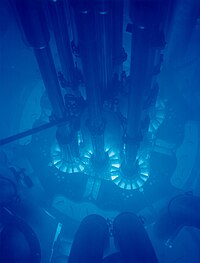
Photo from wikipedia
We report on the observation that low-energy positrons incident on a phosphor screen produce significantly more luminescence than electrons do. For two different wide-band-gap semiconductor phosphors (ZnS:Ag and ZnO:Zn), we… Click to show full abstract
We report on the observation that low-energy positrons incident on a phosphor screen produce significantly more luminescence than electrons do. For two different wide-band-gap semiconductor phosphors (ZnS:Ag and ZnO:Zn), we compare the luminescent response to a positron beam with the response to an electron beam. For both phosphors, the positron response is significantly brighter than the electron response, by a factor that depends strongly on incident energy (0-5 keV). Positrons with just a few tens of electron-volts of energy (for ZnS:Ag) or less (for ZnO:Zn) produce as much luminescence as is produced by electrons with several kilo-electron-volts. We attribute this effect to valence band holes and excited electrons produced by positron annihilation and subsequent Auger processes. These results demonstrate a valuable approach for addressing long-standing questions about luminescent materials.
Journal Title: Physical review letters
Year Published: 2018
Link to full text (if available)
Share on Social Media: Sign Up to like & get
recommendations!